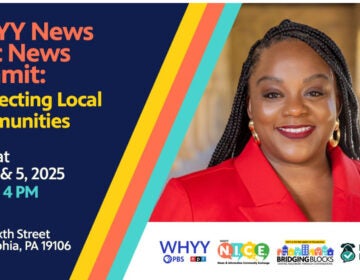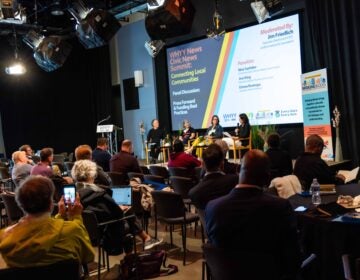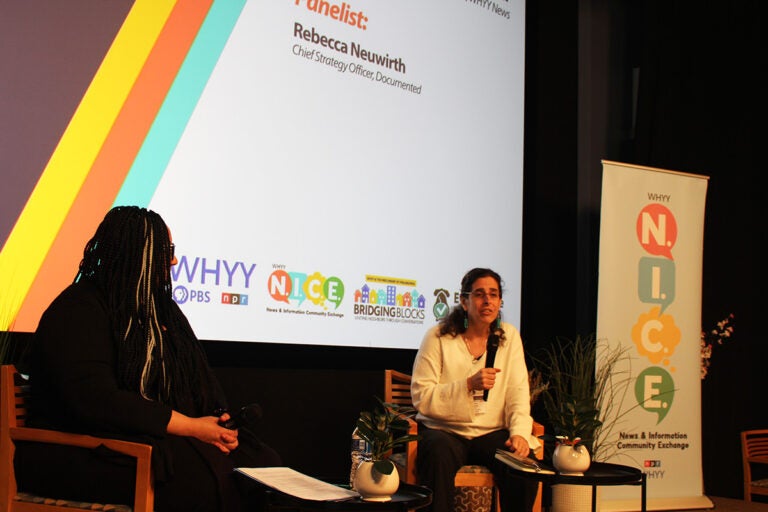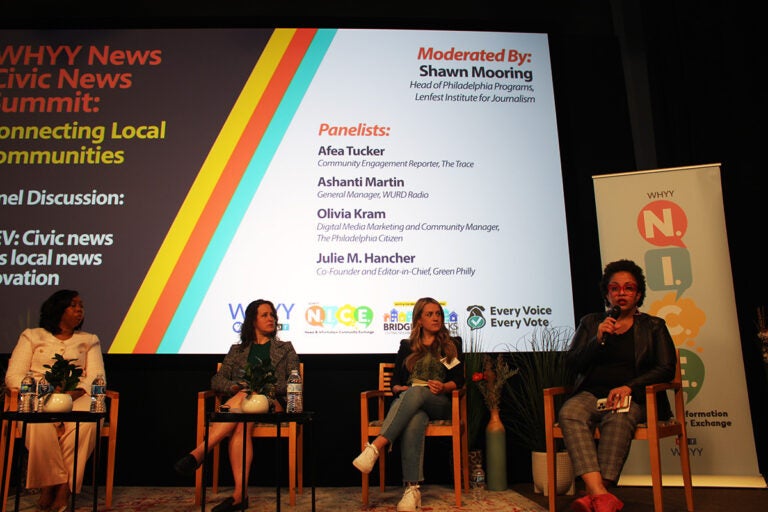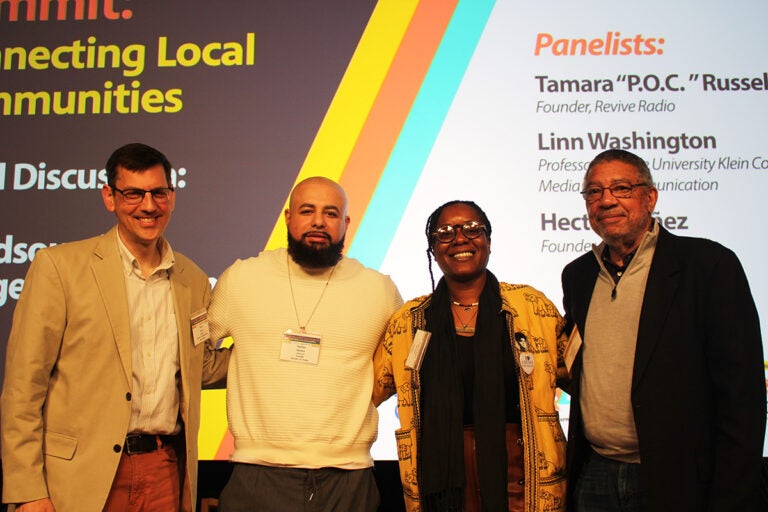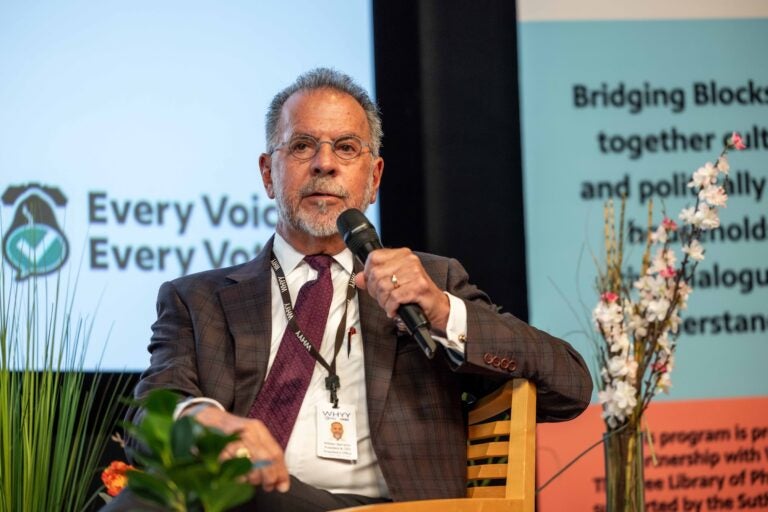WHYY News’ Civic News Summit: 5 trends in civic news
Panelists from a range of different media organizations and platforms shared their insights and best practices about an ever-changing industry.
Listen 1:01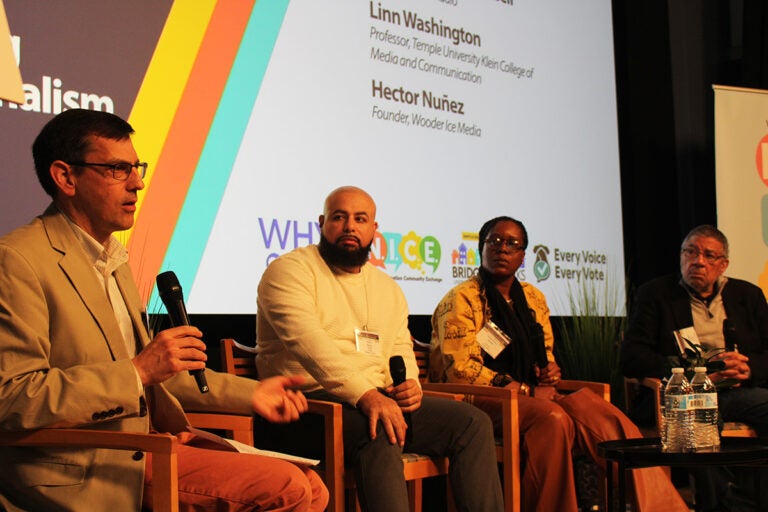
From left to right, Gene Sonn, Hector Nuñez, Tamara "P.O.C." Russell, and Linn Washington discuss crowdsourcing engaged journalism at the WHYY News Civic Dialogue Summit on April 5, 2025. (Emily Neil/WHYY)
From Philly and the Pa. suburbs to South Jersey and Delaware, what would you like WHYY News to cover? Let us know!
On the second day of WHYY News’ Civic News Summit, panelists and attendees discussed how journalists and media makers from a range of different mediums and platforms can better meet their audiences’ information needs and engage community members.
Here are five key takeaways about how journalists and media organizations can improve engagement and best serve their communities.
Cultivate community dialogue
Leaders of the Bridging Blocks initiative, a partnership between WHYY and the Free Library of Philadelphia, facilitated a session showcasing how their programs draw together people of different backgrounds with diverse opinions to discuss pressing and sometimes even controversial issues such as gentrification, immigration, public safety and Philly traditions. The focus is creating spaces for people to engage with topics “that may be difficult to talk about or just challenging and complex,” said Brisa Luzzi Castro, community convener on WHYY News’ community and engagement team.
The group agreements for the dialogue, which started as small group conversations and led into a larger group discussion, included:
- Come with an open mind
- Listen to learn
- Respect the person speaking and their lived experiences
- No personal attacks, confront the idea, NOT the individual
- Facts are universal. Opinions are subjective
Attendees discussed the potential impact on the free society as the free press evolves, and whether new methods for news and information dissemination should be explored.
The program illustrates the importance of helping community members engage with one another when they have different opinions, said Tony Cuffie, senior manager for community and engagement at WHYY News.
“It’s much more about what the audience has to say and the things that they’ve internalized, and this gives them an opportunity to express them in an open forum without judgment, and that’s really what it comes down to,” he said. “You hear so many times about fights breaking out at the Thanksgiving table because you can’t talk about certain subjects. Everybody comes to Bridging Blocks expecting to potentially hear something, an opinion, that differs from their own. And that’s the beauty of the program.”
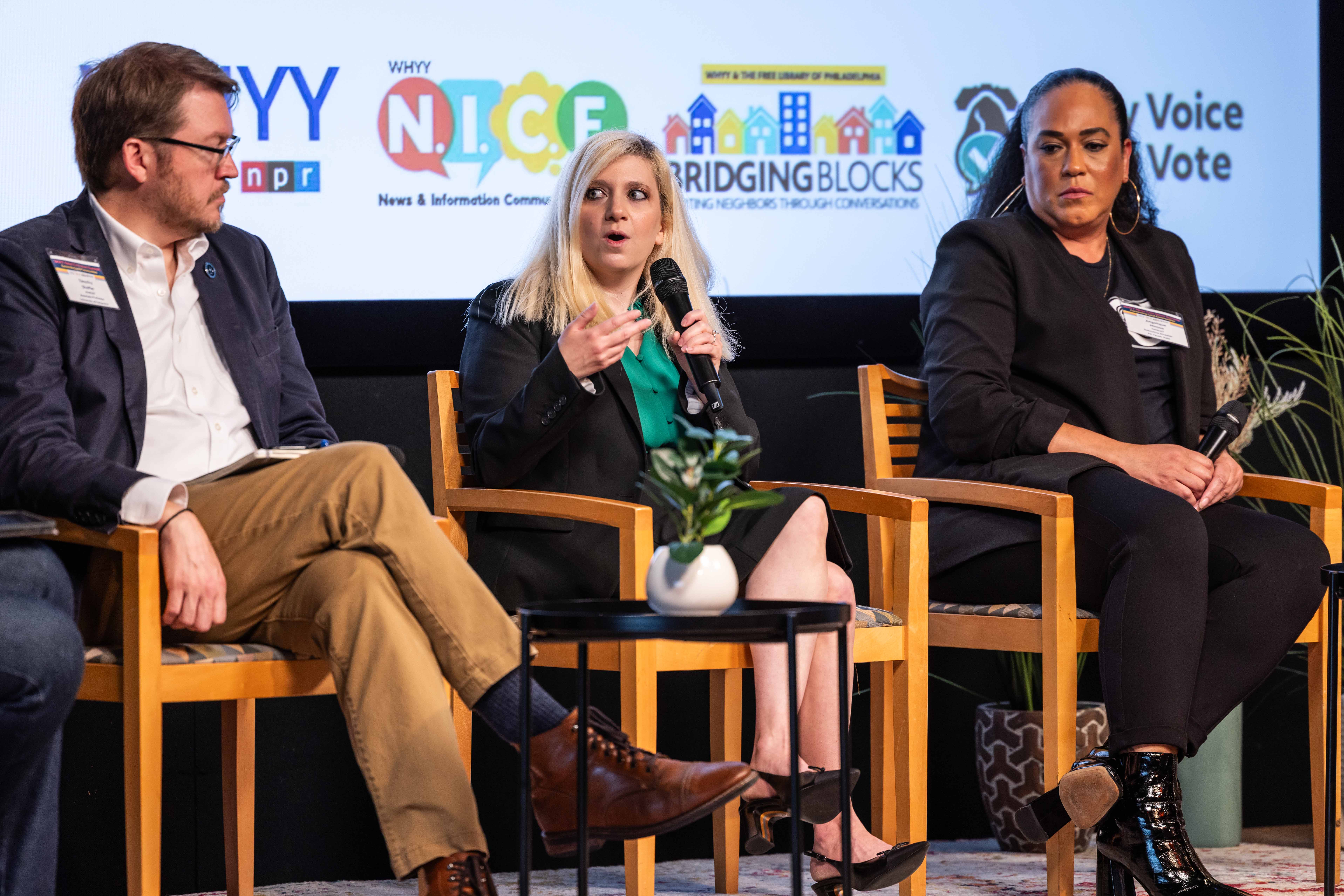
Meet people where they are
A number of panelists and attendees said journalists, news organizations and entrepreneurs should meet people where they are. That might mean using different digital media platforms, or translating stories into languages spoken by a large number of community members. It also means thinking about communicating concepts and information in a way that is accessible for people with a variety of literacy skills, said Emma Tramble, an engagement strategist and event attendee .
“Whenever we talk about news dissemination, we have to think about people at all different levels of understanding, all different levels of education, and people where the educational institutions have failed them,” she said.
Tamara “P.O.C.” Russell, founder and host of Revive Radio, said in a panel about crowdsourcing engaged journalism that it all comes down to starting the conversation.
“One term we always say is pull up on me,” she said. “If you pull up on me, we can talk about whatever you want to talk about or we could deliver that message or get that story out in a way in which it will be relatable to the people who are listening to you.”
That also means getting out there to meet people on the ground, outside of reporting a story on deadline.
“Reporters need to know what’s going on in the community, and you can’t do that by parachuting in and parachuting out,” said Linn Washington, professor at Temple University.
Hector Nuñez, founder of WooderIce.com, echoed Washington’s sentiment.
“Show up in spaces that you normally don’t show up at, meet people you normally wouldn’t meet,” he said. “And then once they develop that trust and that ingrained in the community, it would be a lot easier to tell your story, not only from the outside, from the inside out as well.”
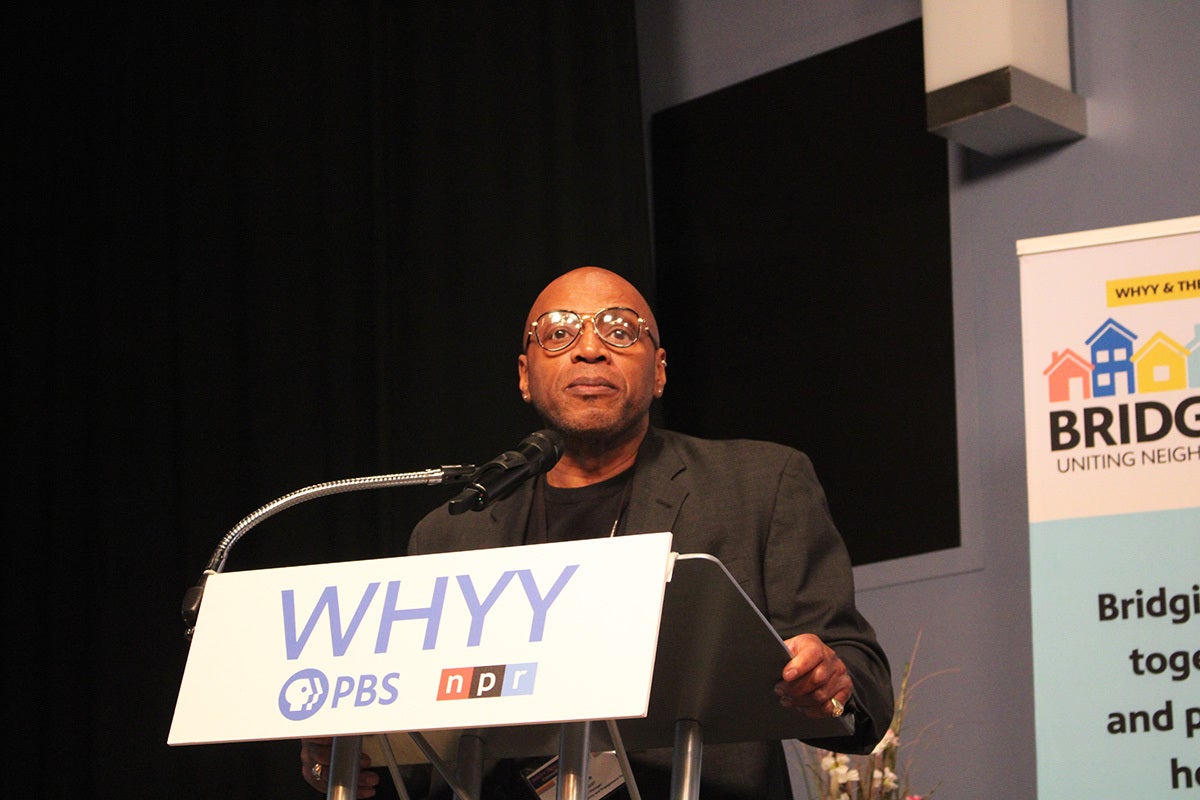
Grassroots, traditional media outlets should collaborate
Panelists discussed the importance of collaboration among traditional and nontraditional or grassroots media outlets.
Grassroots journalists and media outlets like his own have an advantage over traditional media organizations, Nuñez said.
“They feel like it’s somebody in the community talking,” he said of his work at Wooder Ice. “I’m not somebody, a transplant telling them about their neighborhood and whatnot. And I’m being more inclusive.”
Russell said nontraditional and traditional media can find common ground and amplify each other’s work. An example of that, she said, is the work of the Philadelphia Journalism Collaborative.
“As far as being a trusted source, you know, we have to find a way to work with traditional media,” she said. “It’s not going anywhere, right? They have the big brands, they have the big stages. But at the same time, we can be collaborative, right? We can collaborate with each other.”
Panelists discussing the Every Voice Every Vote initiative also highlighted how content sharing and collaboration among smaller newsrooms can advance important work to meet community members’ information needs.
“There’s a lot of power in being small but being a big group together,” said Olivia Kram, digital media marketing and community manager at The Philadelphia Citizen. By joining together with other newsrooms to advance each other’s work, Kram said, that helps counter traffic changes from search engines such as Google that privilege artificial intelligence.
Build partnerships outside of journalism to serve audiences
Rebecca Neuwirth, chief strategy officer at Documented, a nonprofit newsroom reporting with and for immigrant communities in New York City, described how the organization has built relationships with public libraries, schools, community organizations, the International Rescue Committee and a range of institutions to better serve their audience.
It’s vital for media organizations to understand, she said, “how important journalism is as part of an ecosystem of activism in our communities and in our country, and really to understand how we’re playing a role in conjunction with many others, and what it could look like for us to think more expansively about how we relate to the other folks in that while still having the integrity and the training and the discipline that is journalism.”
Neuwirth said Documented prioritizes those relationships to be able to fulfill their mission of giving community members the information they need.
“Our work is only effective if we’re actually genuinely reaching the people who we are working with and and the only way to do that is to genuinely listen and to think of their needs,” she said. “So I guess the biggest thing is just this unrelenting focus on how do we get and engage with and listen to the communities that we want to reach, and the deep knowledge that that is the most important work.”
Neuwirth said an example of how these partnerships amplify the newsroom’s work is the Wage Theft Monitor that Documented built and translated into Spanish and Chinese. The tool is “the largest public repository of data on New York businesses found guilty of wage theft.” The information is then made accessible to the people who are most in need of it through community partners, and shared widely with the workers who are most at risk for being victims of wage theft.
“We’re just at the beginning of what it looks like for journalism to really build deep partnerships with other people who care equally about the work that we’re doing, and can use our data and information to build the credibility and knowledge of the constituents that they’re working with,” she said.
Write about everyday actions, concerns for your audience
Panelists throughout the day stressed the importance of writing about local issues and engaging audience members by sharing information they can put into action.
Candice Fortman, JSK fellow at Stanford University and former executive director of Outlier Media, said her “north star is to be of service.”
One of her first experiences of what it means to be a journalist and be of service, she said, traces back to her “first assignment editor,” her mom, who told her to make a flyer to tell people on her block that trash day was changing.
“She was the first person who gave me an assignment to inform a community about a change happening, and that is the same spirit I brought to Stanford, right?” Fortman said. “I am thinking often about why I do this work, why we inform communities, why we talk to our neighbors, why we must build community first as newsrooms, and from there, everything else will form. The technology you build, the resources that you need to do it, should be foundationally set on your ‘why.’”
Fortman said in order to be of service in that way, journalists need to be directly responding to their audience’s concerns.
“We need to be asking our communities what it is they need from us, how they need us to say things plainly and do it in that way,” she said. “And there is a give and take on that.”

Get daily updates from WHYY News!
WHYY is your source for fact-based, in-depth journalism and information. As a nonprofit organization, we rely on financial support from readers like you. Please give today.



